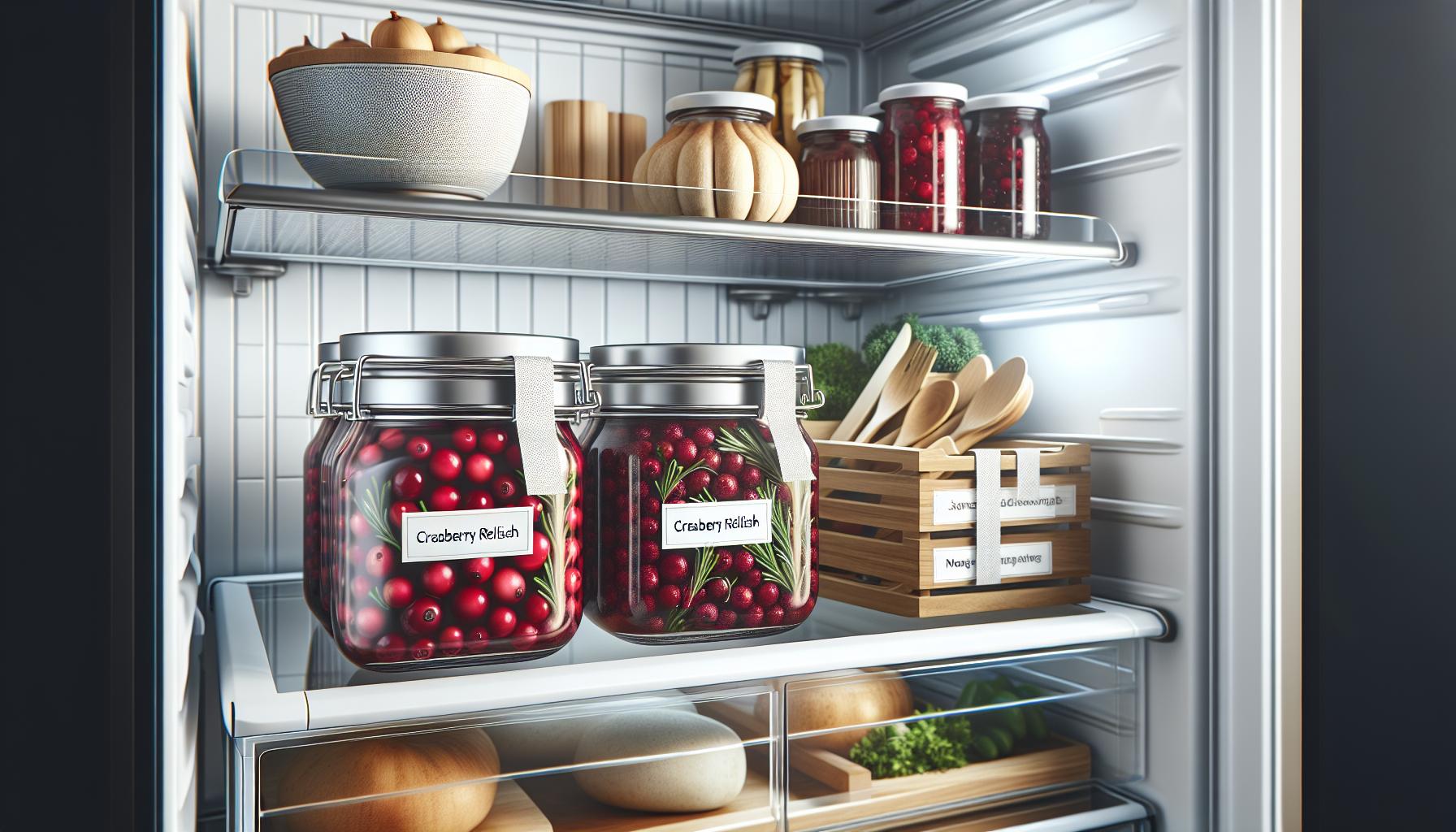Cranberry relish can elevate any meal, adding a burst of flavor and vibrant color. However, understanding how long it lasts in the fridge is essential to ensure you enjoy it at its best. Many people find themselves wondering not just about its shelf life, but also about how to store it safely to avoid spoilage and waste.
Storing your cranberry relish properly matters, especially if you want to enjoy its deliciousness beyond the first few days. Factors like temperature and exposure can significantly impact its quality. Whether it’s homemade or store-bought, knowing the right storage techniques can help you maximize freshness and flavor, allowing you to savor the zesty taste of this beloved condiment in your dishes.
Curious about keeping your cranberry relish tasty for as long as possible? Dive into our guide, where we’ll break down storage tips, shelf life, and signs of spoilage to ensure you get the most from your cranberry delight!
How Long Can Cranberry Relish Be Stored in the Fridge?
Cranberry relish is a delightful addition to many meals, but knowing how long it can safely be stored in the fridge is essential to avoid spoilage. Generally, when stored properly, homemade or commercially prepared cranberry relish can stay fresh in the refrigerator for about 2 to 4 weeks. However, this timeframe may vary depending on several factors such as the ingredients used, the cleanliness of storage containers, and the temperature stability inside your fridge.
To maximize the longevity of your cranberry relish, it’s important to cool it completely before placing it in the refrigerator. This practice helps to prevent condensation that can promote mold growth and spoilage. Airtight containers are ideal as they keep out moisture and air that can degrade the quality of the relish. Always check your refrigerator’s temperature setting; it should ideally be below 40°F (4°C) to ensure food safety.
When approaching the end of the storage period, be mindful of any signs that could indicate spoilage. Discoloration, off smells, or an unusual texture can all suggest that the relish is no longer safe to eat. Keeping an eye on these factors can help ensure your cranberry relish remains a safe and tasty accompaniment to your meals for weeks to come.
Factors Affecting the Shelf Life of Cranberry Relish
Cranberry relish can be a star addition to your festive meals, but several key factors influence how long this tangy condiment remains safe and tasty in your fridge. Understanding these influences is crucial to maximizing its shelf life and ensuring optimal flavor.
One major factor is the *ingredient quality*. Fresh ingredients that are high in acidity, like cranberries and citrus, naturally inhibit bacteria growth, enhancing shelf life. However, if you incorporate other ingredients, such as nuts or dairy, which have different preservation properties, the overall longevity can be affected. The shelf life of cranberry relish can differ significantly, with homemade versions generally lasting about 1 to 3 weeks and store-bought varieties lasting up to 6 weeks, thanks to preservatives that thwart spoilage ([[2]]).
Another critical element is *storage conditions*. Ensuring your relish is stored in an *airtight container* is vital to minimize exposure to air and moisture, which can expedite spoilage. A clean environment is also important; bacteria and mold thrive in unhygienic conditions, potentially shortening the relish’s lifespan. Additionally, maintaining a refrigerator temperature of 40°F (4°C) or lower is crucial for food safety. Regularly check your fridge’s functioning to safeguard your cranberry dish against temperature fluctuations.
Lastly, *time since preparation* plays a significant role; the sooner you consume cranberry relish after making or purchasing it, the fresher and safer it will taste. By understanding these factors, you can enjoy your cranberry relish at its best and avoid unnecessary waste.
Signs Your Cranberry Relish Has Spoiled
When it comes to enjoying cranberry relish, it’s essential to keep an eye out for signs that your batch may have gone bad. Knowing how to identify spoilage will help ensure that you don’t inadvertently consume something unsafe. Typically, spoiling occurs due to the growth of bacteria or mold, which can compromise both safety and taste.
One of the most apparent indicators is a change in smell. Fresh cranberry relish should have a tart, fruity scent. If you detect a sour or off-putting smell, it’s a strong sign that it has spoiled. Similarly, visually inspecting the relish can provide helpful clues. Look for any visible mold growth, which can appear as fuzzy spots of green or white on the surface. If you see these signs, discard the relish immediately.
Another factor to consider is the texture. Fresh cranberry relish is usually thick and slightly chunky. If it has become overly watery or has separated significantly, it may be time to throw it out. Additionally, take note of any changes in color, especially if the vibrant red or pink hue has dulled or turned brown. These visual changes can indicate that the acids in the relish have broken down, leading to spoilage.
Lastly, trust your taste. If you cautiously taste a small spoonful and it has developed an off flavor that is different from its original tangy sweetness, it’s best to err on the side of caution. When it comes to food safety, it’s better to avoid consuming questionable items, especially when spoilage signs are present. Keep these guidelines in mind to ensure that your culinary creations remain safe and delightful!
Best Storage Practices for Cranberry Relish
To maintain the flavor and safety of cranberry relish, proper storage is key. Fresh cranberry relish can last in the refrigerator for about 1 to 2 weeks when stored correctly. However, improper storage can lead to quicker spoilage, diminishing its taste and texture.
To store cranberry relish effectively, begin by allowing it to cool to room temperature after preparation. This step is crucial as placing hot or warm relish directly into the refrigerator can cause condensation to form, which may promote mold growth. Transfer the relish into an airtight container to seal out air, which can lead to oxidation and dried-out texture. Placing a layer of plastic wrap directly on top of the relish before securing the lid can provide an additional barrier against air.
Keep the relish in the coldest part of the refrigerator, typically near the back, where temperatures are most consistent. Avoid storing it in the fridge door, as this area is subject to temperature fluctuations every time the door opens. To maintain its best quality, consume the relish within the recommended timeframe and label the container with the date it was made or stored. Doing this will help keep track of freshness and avoid waste.
For longer-term preservation, consider freezing any leftover cranberry relish. When frozen in an airtight container or freezer-safe bag, it can last for up to three months without significant loss of flavor or nutrients. Before freezing, ensure the relish is cool completely, and remember to leave some room for expansion as the liquid freezes. With these practices, you can enjoy your cranberry relish safely and deliciously for longer.
How to Extend the Freshness of Cranberry Relish
To keep cranberry relish tasting fresh and delicious for as long as possible, several best practices can be implemented. The key is to minimize exposure to air and temperature fluctuations, both of which can hasten spoilage. Here are some effective strategies:
- Cool Before Storing: Always allow the cranberry relish to cool to room temperature before refrigerating. Placing hot relish directly into the fridge can cause condensation, fostering an environment conducive to mold growth.
- Use Airtight Containers: Transfer the relish into an airtight container as soon as it’s cooled. This prevents air from oxidizing the relish, which can degrade its flavor and texture.
- Cover with Plastic Wrap: For an extra layer of protection, press a piece of plastic wrap directly onto the surface of the relish before sealing the container. This barrier helps to avoid air pockets that may lead to spoilage.
- Keep It Cold: Store the container in the coldest section of your refrigerator-typically the back. Avoid placing it in the door, where temperature fluctuations can occur with every opening.
- Label and Date: Always label your container with the date it was made or stored. This simple action not only helps in tracking freshness but also ensures you consume it within the optimal timeframe of 1 to 2 weeks.
Additionally, if you anticipate not being able to use the relish within this period, consider freezing it. Properly frozen cranberry relish can last up to three months while maintaining its flavor and nutritional value. Just remember to let it cool completely before transferring it to a freezer-safe bag or container, and leave some space for expansion as it freezes.
By following these practices, you can effectively extend the freshness of your cranberry relish, keeping it tasty and safe for consumption!
Creative Ways to Use Leftover Cranberry Relish
Utilizing leftover cranberry relish can not only reduce food waste but also elevate your culinary creations. With its tartness and sweetness, cranberry relish can enhance a variety of dishes. Here are some creative ideas for incorporating this vibrant condiment into your meals, keeping in mind that it should ideally be consumed within two weeks of preparation.
One delicious way to enjoy cranberry relish is by mixing it into your morning yogurt or oatmeal. The relish adds a delightful burst of flavor, transforming a simple breakfast into a gourmet experience. Simply stir in a spoonful of your homemade relish for an extra kick of tang. It pairs particularly well with creamy Greek yogurt, cutting through its richness.
Savory Dishes
Cranberry relish can also be a fantastic addition to your savory dishes. Consider using it as a topping for grilled chicken or turkey. The sweet-tart profile complements the flavors of the meat beautifully. For a quick and easy dish, slather a layer of cranberry relish over a baked brie cheese; when melted, it creates a stunning appetizer that’s perfect for gatherings. You could also fold some into a salad dressing for an interesting flavor twist; mix together cranberry relish, olive oil, and a splash of vinegar for a refreshing vinaigrette.
Sandwiches and Wraps
Adding cranberry relish to sandwiches or wraps can elevate your lunch. It pairs wonderfully with turkey and cheese, providing a contrast that makes each bite special. Spread it on whole-grain bread for a delightful turkey sandwich, or use it as a condiment in a wrap with mixed greens and grilled vegetables.
Creative Desserts
Don’t overlook cranberry relish as a dessert ingredient! Swirl it into cheesecake batter or use it as a filling for pastries or tarts. It also makes a great topping for vanilla ice cream or pancakes, delivering a burst of flavor that can turn ordinary desserts into extraordinary ones.
By experimenting with these ideas, you can ensure that your cranberry relish doesn’t just sit in the refrigerator but becomes a vibrant part of your meals. Just remember to keep an eye on its freshness and flavor for the best taste experience.
Freezing Cranberry Relish: Is It Possible?
Freezing cranberry relish is a fantastic option for those looking to extend its shelf life and enjoy its vibrant flavors long after the initial preparation. When stored properly in an airtight container or freezer bag, cranberry relish can retain its taste and quality for up to three months. This makes it an excellent way to preserve leftovers and prevent waste, especially after holiday meals or gatherings where relish is often served.
Before freezing, ensure that the cranberry relish has cooled completely to room temperature. This step is crucial, as placing hot food directly into the freezer can raise the temperature inside and potentially affect the safety of other items stored within. To freeze, simply transfer the relish into a freezer-safe container, leaving about an inch of space at the top. This extra room allows for expansion as the relish freezes. For added protection against freezer burn, consider wrapping the container in plastic wrap or aluminum foil as an additional barrier.
When you’re ready to use the frozen cranberry relish, the best method for thawing is simply to transfer it to the refrigerator and allow it to defrost overnight. This slow thawing process helps to maintain the relish’s texture and flavor. After thawing, be sure to consume it within a week for the best quality. If you notice any changes in texture or flavor, it may be wise to discard the relish. To keep the experience delightful, use thawed cranberry relish in various dishes, such as topping desserts, enhancing salads, or incorporating it into savory meals.
Cranberry Relish vs. Cranberry Sauce: What’s the Difference?
The distinction between cranberry relish and cranberry sauce is rooted in both preparation methods and resulting textures, making them uniquely suitable for various culinary occasions. Cranberry sauce, typically cooked, develops a thick, smooth consistency as it simmers. This cooking process often involves added sugars, spices, and additional ingredients, leading to a sweeter taste that pairs well with savory dishes, particularly during holiday meals. Once cooled, cranberry sauce can set firmly, creating a jelly-like texture that slices neatly, making it easy to serve alongside turkey or roast meats.
In contrast, cranberry relish is prepared using raw cranberries, resulting in a fresher, more vibrant option. This no-cook method retains the tartness of the cranberries, often balanced with sweet elements such as sugar, apples, or oranges. The texture of relish is chunkier and offers a delightful crunch, making it a bright addition to dishes like salads or served as a condiment. As relish does not undergo the thickening process that sauce does, it remains more fluid and closer to its fresh state, leading to a lively flavor profile that complements appetizers or as a side to richer entrees.
Understanding these differences can enhance your culinary experience, allowing you to select the appropriate accompaniment based on the flavors and textures you desire. While both serve delicious purposes, choosing between them largely depends on your meal’s requirements and your personal preference for sweetness versus tartness. Using both in tandem can also create a dynamic spread for festive gatherings, showcasing the versatility of cranberries in various forms.
Pairing Ideas for Cranberry Relish to Enhance Flavor
Cranberry relish is not only a vibrant addition to meals, but it also pairs beautifully with various foods, enhancing flavors and adding a refreshing tartness. Whether you’re planning a festive feast or just looking to elevate your everyday dining, exploring delicious pairings with cranberry relish can transform mundane dishes into gastronomic delights.
For instance, savory meats find a perfect companion in cranberry relish. The bright acidity and sweetness of the relish complement rich flavors in dishes like roasted turkey, pork loin, or duck, cutting through the richness and balancing the palate. Adding a spoonful of cranberry relish on top of a grilled chicken breast or a hearty steak can elevate the dish dramatically, providing a burst of flavor that contrasts with the savory elements.
Vegetable dishes also shine when paired with cranberry relish. It acts as a refreshing condiment over roasted Brussels sprouts, sweet potato mash, or even a simple green salad. The crunchy texture and bright taste can notably enhance the freshness of salads, especially those with nuts or cheese, such as goat cheese or feta. For cheese boards, consider serving cranberry relish alongside creamy Brie or sharp cheddar, as it offers a wonderful contrast that elevates the tasting experience.
When it comes to sweet dishes, cranberry relish can bring a surprising twist. Its tartness complements desserts like vanilla ice cream or cheesecake, adding a refreshing counterpoint to the sweetness. Drizzling cranberry relish over pancakes, waffles, or yogurt creates an exciting breakfast or brunch option, infusing vibrant color and flavor that can turn a simple meal into something special.
Exploring these pairings not only enhances the flavor profile of your dishes but also invites guests to explore new culinary experiences. By integrating cranberry relish thoughtfully into your meals, you can enjoy its freshness while celebrating food safety and quality, ensuring that your fare remains delicious and appealing.
Q&A
Q: How long can cranberry relish be kept out of the fridge?
A: Cranberry relish should not be kept out of the fridge for more than two hours. After that time, the risk of bacterial growth increases. Always refrigerate any leftover relish promptly after serving for optimal safety.
Q: Can you eat cranberry relish after the expiration date?
A: Generally, cranberry relish is safe to eat for a short time after the expiration date if it has been stored properly. Check for signs of spoilage like odor or mold before consuming. If in doubt, it’s best to err on the side of caution.
Q: How can you tell if cranberry relish has gone bad?
A: Signs that cranberry relish has spoiled include an off-odor, unusual texture, or visible mold growth. Always check the relish visually and by smell before consuming to ensure its safety.
Q: Is it safe to freeze cranberry relish in glass containers?
A: While it is possible to freeze cranberry relish in glass containers, ensure they are suitable for freezing to prevent breakage. Use freezer-safe containers or bags to maintain quality and prevent freezer burn.
Q: What can you do with leftover cranberry relish?
A: Leftover cranberry relish can be used as a topping for yogurt, spread on sandwiches, or incorporated into salad dressings. Get creative with your leftovers to enhance various dishes.
Q: What is the best way to reheat cranberry relish?
A: The best way to reheat cranberry relish is on the stove over low heat or in the microwave in short intervals, stirring frequently until warm. Do not overheat to avoid loss of flavor and texture.
Q: How does homemade cranberry relish compare to store-bought in terms of shelf life?
A: Homemade cranberry relish generally has a shorter shelf life than store-bought due to the absence of preservatives. While homemade can last up to three weeks in the fridge, store-bought can often last longer, up to six months, if unopened.
Q: Can you incorporate cranberry relish into baked goods?
A: Yes, cranberry relish can be a delightful addition to baked goods such as muffins or cakes. Use it in recipes where moisture can enhance flavor, but adjust other wet ingredients to prevent sogginess.
For more tips on storage and using your cranberry relish creatively, check out sections on best storage practices and creative uses in our main article!
Concluding Remarks
Now that you know how long cranberry relish lasts in the fridge, you’ll want to make sure it stays as delicious as possible! Generally, your homemade cranberry relish will stay fresh for about 1-2 weeks when stored in an airtight container. For optimal flavor, consider using it within the first week. Don’t hesitate to whip up a batch whenever you want to elevate your meals-it’s perfect on turkey sandwiches or as a tangy addition to salads!
For more tips on storing seasonal favorites, check out our guides on preserving other holiday dishes or learn how to create a classic cranberry sauce. If you enjoyed this content, don’t forget to subscribe to our newsletter for exclusive recipes and tips delivered straight to your inbox. We’d love to hear your thoughts, so feel free to share your experiences or ask any lingering questions in the comments below. Ensuring your meals are tasty and safe is what we’re all about-happy cooking!





